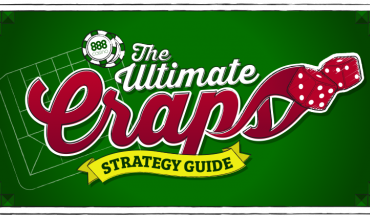HOW TO PLAY CRAPS
THE BASIC RULES WHEN PLAYING CRAPS
- Craps has dozens of wagers available, but the game is structured around the pass line bet.
- Players bet by placing chips on the pass line on the craps layout. Some other bets require that the dealer move your chips.
- The pass sequence starts with a comeout roll and the shooter rolls the dice.
- Pass bettors win if the roll is 7 or 11 and lose if it is 2, 3 or 12. Any other number becomes the point.
- If the shooter rolls a point number on the comeout, he keeps rolling until either he rolls the same number again to win an even-money payoff, or rolls a 7 to lose.
- If the shooter makes his point, he keeps rolling with a new comeout. If he doesn’t, he “sevens out,” and the dice rotate to a new shooter
Craps can be as simple as betting on one number and either winning or losing on each roll, or as complex as making a bet, waiting until the shooter rolls a target, or “point” number, then hoping the shooter can roll the same number again. That procedure can go on for any number of rolls.
Let’s start with a look at the craps layout, then explain the available layouts.
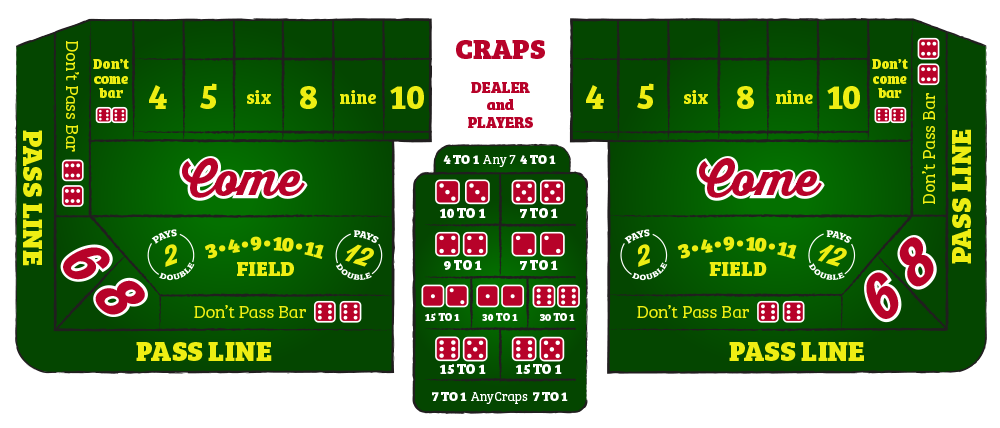
Each area of the craps layout signifies a different bet. If your chips are on the pass line, you’re making a pass bet, which is a multi-roll wager. If your chips are in the box that displays images of dice showing a 6 and a 5, you’re making the one-roll bet on 11. When you’re playing online craps, you can make any of the bets by clicking the layout on the screen. It’s different in live casino play. There, you can bet on pass, don’t pass, come, don’t come and the field by putting your own chips on the layout. For other bets, you put your chips directly in front of you on the layout and tell the dealer what you want. If you want to bet $5 on the place bet on 4, you would put $5 in chips in front of you, tell the dealer, “$5 place on 4,” and the dealer then would move your chips to the 4 box.
Let’s take a look at commonly available wagers and break that down into multi-roll and single-roll bets. You can have more than one bet in action at once – in fact most craps players have several bets working at a time. Not every possible wager is listed, though house edges for wagers such as lay bets – betting on 7 to come up before a place number – and horn bets are listed in the chart in the final chapter.
![]()
HOW TO PLAY MULTI-ROLL BETS
PASS
House edge: 1.41%
Winning bets are paid even money, but when non-craps players say the game confuses them, this is usually the bet they have trouble following. It usually takes more than one roll to decide, and while 7 starts out being a good roll for players it ends up being a losing number.
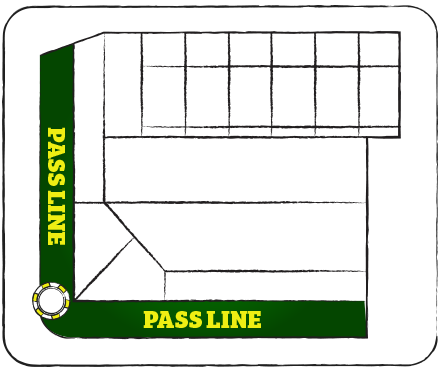
But really, it’s not all that complicated. Casinos aren’t in the business of making rules so intimidating they chase potential players away from the tables. If we don’t play, the operators can’t make money.
The pass line sequence starts with a “comeout roll.” You can tell if the next roll is a comeout by the placing of a disc on the table. If the disc is toward a corner of the layout and is turned so the face-up side is black with the word “off,” then the next roll is a comeout. If the disc is in a numbered box and has a white side saying “on” face up, then the pass sequence already is underway and the next roll is not a comeout.
On the comeout, if the shooter rolls a 7 or 11, pass bets win. If the shooter rolls 2, 3 or 12, pass bets lose. If the shooter rolls 4, 5, 6, 8, 9 or 10, that number becomes the point and the object of the game changes. Now the shooter must roll that number again before rolling a 7.
No other rolls matter in deciding the pass bet. If the point is 6 and the next several rolls are 4, 8, 3, 11, 5, 12, for example, the pass bet just stays in action. The bet isn’t decide until the shooter either rolls the point again or rolls a 7.
COME
Come is the same bet as pass, except you make it when there already is a point for pass bettors. If the next roll is a comeout, then the bet you want is pass. If there already is a point, then you can bet come and the next roll is treated as a sequence starter for your come bet.
Let’s say that on the comeout the shooter rolls a 6, and that becomes the point. Before the next roll, you bet on come. Then if the shooter rolls a 7 or 11, your come bet wins, if he rolls 2, 3 or 12 the come bet loses and any other number becomes a point for your come bet.
Note that the same 7 that wins on your come bet could lose on the pass line, and a 2, 3 or 12 that loses on come will have no effect on pass. Say 6 is established as a point on craps and you follow with a come bet. If the next roll is 7, you win on come but lose on pass. If it’s 11, you win on come and your pass bet stays in action, and if it’s 2, 3 or 12 you lose on come and your pass be stays in action.
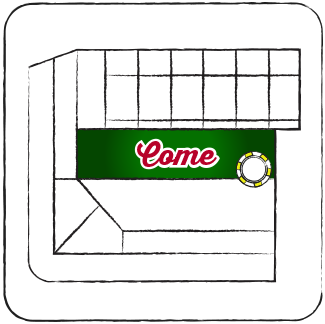
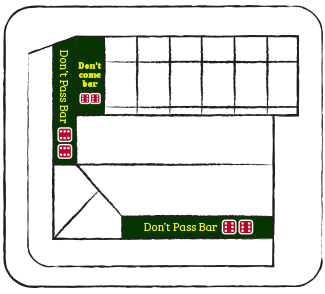
DON’T PASS AND DON’T COME
House edge: 1.36%These are the near opposites of pass and come. Like them, you bet don’t pass if the next roll is a comeout and don’t come if it isn’t.
On the comeout for a don’t pass bet or on the first roll after making a don’t come bet, you win if the roll is 2 or 3 and lose if the roll is 7 or 11. You don’t win if the roll is 12 even though 12 is a loser at the start of pass or come sequences. Instead, the bet is a push and you can take your money back after a 12. If the roll is any other number, it becomes the point. If a 7 rolls before the point is repeated, don’t bettors win, and if the point comes first, they lose – the opposite of pass or come.
Most players prefer playing the pass side so they are rooting for the shooter and have the camaraderie of winning together. They refer to don’t players as “wrong bettors” and “the dark side.” But the house edge is slightly lower on the don’ts and the dark side has its followers.
FREE ODDS / LAY ODDS
House edge: 0%
Winning bets are paid at true odds, varying according to point number. It’s rare that you get an even break on casinos games, but the odds give you just that. They’re called “free odds,” but it’s not a free bet – you still have to but money at risk. The “free” just signifies that there is no commission or other method of making this bet profitable for the house.
In order to take free odds, you must first make a pass or come bet. After a point is established, you may back your pass or come bet with a second wager. Originally, that free odds bet had to be equal to your pass or come bet, but today most casinos allow you to bet multiples of your original bet.
The great part is that the free odds are paid at true odds. If the point number is 6 or 8, a winning free odds bet is paid at 6-5 odds. Payoffs are 3-2 on points of 5 or 9 and 3-1 on 4 or 10.
Those reflect the actual odds of rolling those numbers. Using two six-sided dice, there are 36 possible combinations. Six of them total 7, with there are five each if 6 and 8, four each of 5 and 9 and three each of 4 and 10.
Six ways to roll 7 and 5 ways to roll 6 means the true odds against rolling 6 before 7 are 6-5, exactly the same as the payoff on winners. Hence, no house edge. It works the same way on all the point numbers. Payoffs are the same as the odds against winning the bet. There is no house edge on the odds themselves, though the house retains its edge on the pass or come bet you must make before betting the odds.
If a casino offers single odds, then your odds bet must be equal to your pass or come bet. If the casino offers multiple odds, then your odds bet may be any multiple of the original up to the maximum. When 10x odds are offered for example, your odds bet may be 1, 2, 3, 4, 5, 6, 7, 8, 9 or 10 times your original bet.
Many casinos today offer 3, 4x, 5x odds meaning you may make an odds bet of three times your original wager if the point is 4 or 10, four times if the point is 5 or 9 or five times if the point is 6 or 8. This makes calculating payoffs easy – with maximum odds, total payoffs are the same on any point. If you bet $5 on pass, then a $15 odds bet on 4 or 10 pays 2-1, or $30; a $20 odds bet on 5 or 9 pays 3-2, or $30; and a $25 odds bet on 6 or 8 pays 6-5, or $30.
Don’t pass and don’t come bettors can lay the odds instead. To use a point number of 6 as an example, once that point is established, the don’t bettor has six ways to win – the six possible ways to make 7 – and only five ways to lose – the five ways to make 6. When you lay the odds, you win $5 for every $6 you bet on 6 or 8, $2 for every $3 you bet if the point is 5 or 9, and $1 for every $2 you bet when the point is 4 or 10.
The payoffs reflect the true odds, just as when a pass/come bettor takes free odds. There is no house edge on the lay odds, but the house has an overall edge because you must bet don’t pass or don’t come first.
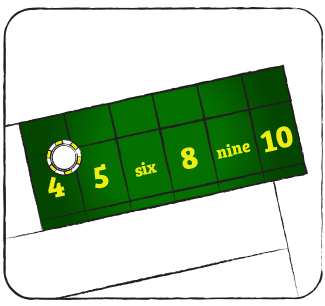
PLACE BETS
House edge 1.52% on 6 or 8; 4% on 5 or 9; 6.67% on 4 or 10Winning bets are paid at 7-6 odds if you’re betting on 6 or 8, 7-5 on 5 or 9 and 9-5 on 4 or 10. Want to choose your number without waiting for the shooter to establish a point on the comeout? Place bets enable you to do just that. When you make a place bet, you’re betting the shooter will roll your number before he rolls a 7. As on pass, no other numbers matter. If you place 6 and the next several rolls are 5, 4, 12, 3, 9, 8, then there is no decision on your bet. You win only if the shooter rolls your number, and lose if he rolls 7. These pay more than even money, but less than true odds. Instead of the 6-5 true odds of making a 6 or 8, those numbers pay 7-6, giving the house it’s 1.52% edge.
One important point: If you place 6 or 8, be sure to bet in multiples of $6 so the house can make that 7-6 payoff. If you bet $5 instead, the house will pay at even money.
Many players like to place 6 and 8, the most frequently rolled winning numbers. Other place numbers, with higher house edges, are less popular.
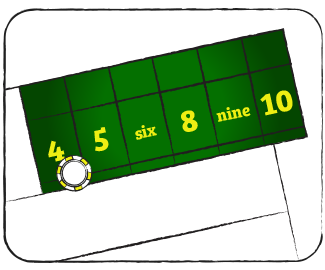
BUY BETS
House edge: 4.76%, or less if commission is only on winners.Winning bets are paid at true odds, but you have to pay the house a 5% commission to get that deal. For example, if you buy the 4 for $20, you must also pay the house a $1 commission. Then if you win, you’re paid at the 2-1 true odds. That lowers the house edge from 6.67% to 4.67% on 4 or 10, but raises the house edge on other numbers.
However, some casinos charge the commission only if you win. That drops the house edge to 2% if you buy 5 or 9 and 1.67% on 4 or 10, making buying a better option than placing. The house edge on buying 6 and 8 under these conditions is 2.27%, so you’re still better off with the 1.52% for a place bet.
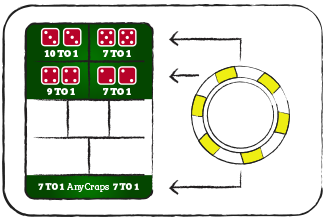
HARDWAYS
House edge 9.09% on 6 or 8; 11.11% on 4 or 10Payoffs are 9-1 on 6 or 8 and 7-1 on 4 or 10. A number rolled the hard way means that both dice show the same number. A hard 4 is a 2 on each die. Hard 6 is 3 on each die, and so on. To win a hardway bet, your number must come up the hard way before the shooter rolls either the 7 or your number any other way. If you bet hard 8 and the roll is 2-6 or 3-5, you lose. Only 4-4 is a winner.
![]()
HOW TO PLAY ONE-ROLL BETS
Before getting into the individual bets, the payoffs listed below are the most common. A one-roll bet on 2 usually pays 30-1, but some casinos, especially in the United Kingdom and Australia, pay 31-1, 32-1 or, rarely, 33-1. The higher the payoff, the lower the house edge.
Also, the listings are odds-to-1. Some casinos pay odds-for-1, which essentially means your bet is included in the payoff. If you bet $1 and are paid 30-to-1, you keep your $1 bet and get $30 in winnings. If you’re paid 30-for-1, $29 in winnings are added to your $1 to give you a total of $30. Beware tables that pay odds-for-1.
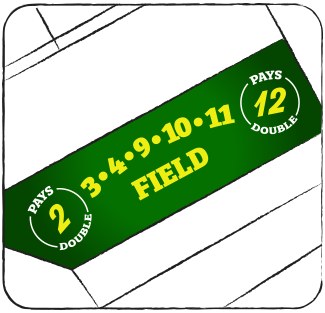
THE FIELD
House edge 5.56% or 2.78%: You win if the next roll is 2, 3, 4, 9, 10, 11 or 12.Winners are paid even money most of the time, but are paid 2-1 if the roll is 2 and either 2-1 or 3-1 if the roll is 12. Some casinos, especially in Reno, Nevada, reverse that and pay 3-1 on 2 and 2-1 on 12. If both 2 and 12 pay 2-1, the house edge is 5.56%. If either pays 3-1, that cuts the edge in half to 2.78%.
2 OR 12
House edge 13.89%Winners are paid 30-1. If you bet on 2 the next roll must be 2. If you bet on 12, the next roll must be 12. All other numbers lose.
3 OR 11
House edge 11.11%
Winners are paid 15-1. If you bet on 3 the next roll must be 3, and if you bet on 11, the next roll must be 11. All other rolls lose.
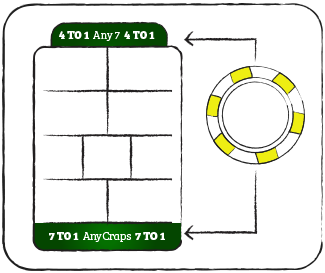
ANY 7
House edge 16.67%:Winners are paid 4-1.
ANY CRAPS
House edge 11.11%:Winners are paid 7-1.
You get three numbers on this bet – you win if the next roll is 2, 3 or 12.
HOP BETS
Winners are paid 30-1 on hard hop bets and 15-1 on easy hop bets.
On hop bet, you’re betting each die will land on a specific number. You tell the dealer,”6-3 hopping” or “4-2 on the hop,” and you win only if the dice show those specific numbers.
On a “hard hop,” both numbers are the same, such as 1-1 or 4-4. When the two numbers are different, the bet is an “easy hop.”
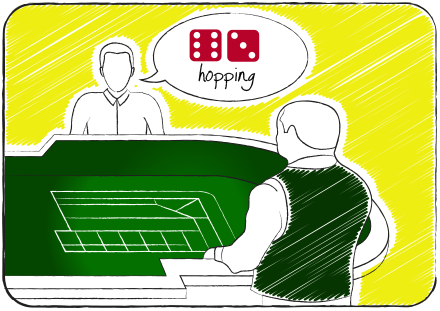
![]()
CRAPS RULES
Craps is the same game online and in live casinos, but some rules and procedures are a little different. Here are a few point every player should know before playing.
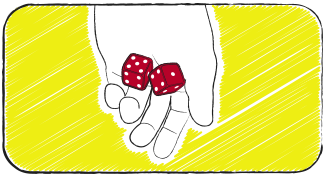
RULE #1: NUMBER OF DICE
Two six-sided dice are used, and you are betting on the total of the numbers that land face up on both dice.
If one die lands on 2 and the other on 4, then the number on that roll is 6. If the numbers are 1 and 1, then the roll is 2.
You cannot bet on each die separately. There is no wager that one die will show No. 1, for example. All craps bets are on two-dice totals.
RULE #2: BUYING CREDITS
At online casinos, as in other games, you start by making a deposit, or if you already have funds on deposit, you may draw on them for money to play.
At live casinos, most players buy in at the table. Some already have chips from previous play and some who have credit accounts at the casino may have chips from having cashed a credit marker.
But most pay as they play. You do so by putting cash on the layout and telling the dealer you want to buy chips. The dealer is not permitted to take cash directly out of you hand. You must put your cash on the table and the dealer then will take it and give you chips.
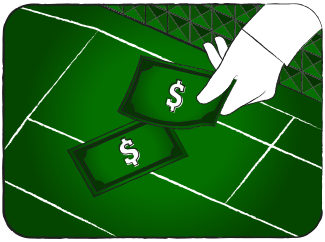
RULE #3: TABLE PERSONNEL
Online, all decisions and payouts are done automatically, but in live casinos there’s a human crew. The common complement is four people: the boxman, the stickman and two dealers.
The boxman is in charge of the table, watching to make sure players follow rules and that dealers make proper payoffs. When you buy in by putting cash on the table, a dealer gives the cash to the boxman, who lays it flat, face down on the table, then watches as the dealer gives you chips. When the transaction in complete, the boxman then uses a flat plastic paddle to push the cash into a drop box, which later will be taken by guards for transport to the count room.
The stickman holds a long hooked stick, which he uses to push dice around the table. When it’s your turn to shoot, the stickman pushes the dice to you. He also handles the proposition bets at the center of the table.
The dealers each are in charge of one end of the table, giving you chips when you buy in, moving your wagers to the appropriate spots on their ends of the table and making payoffs.
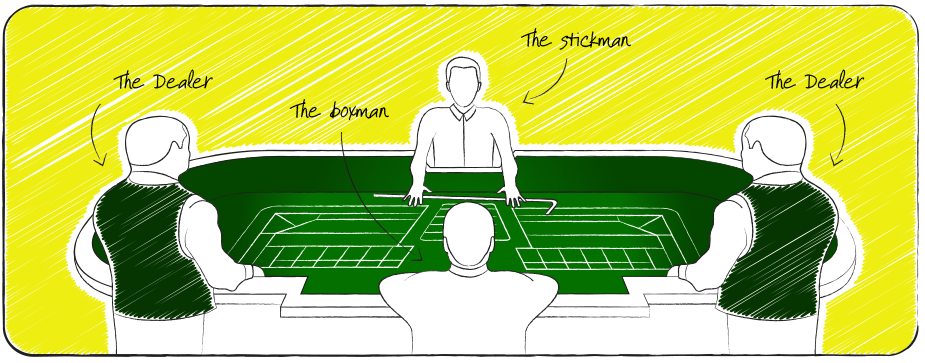
RULE #4: BETTING
At most online casinos, your screen will include a graphic of the craps layout. You may click on chip images to determine how much you want to bet, then again on the screen to place the chips on the bet you want. If you want to make the bet labeled “Pass Line,” you would click on the pass line area. If you want to bet on 11, you would click on a box depicting 11 with images of one die on 6 and one on 5.
At live casinos, you may place your own chips on the pass line and in areas marked “Come” and “Field,” but for must bets, your chips must be placed by the dealer. You push chips in front of you on the layout and tell the dealer, “$6 each on 6 and 8.” The dealer then moves your chips to the appropriate box and positions it in accordance to your position at the table, so he knows both what the bet is and who made it.
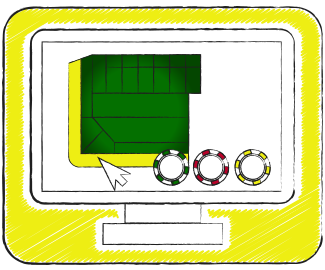
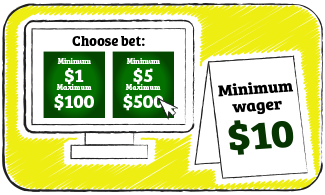
RULE #5: BETTING LIMITS
Online, you’ll usually be asked to choose from a range of minimum and maximum bets. For example, you might be presented with options of minimum bet $1, maximum $100; minimum $5, maximum $500; or minimum $10, maximum $1,000. You choose the range that’s within your comfort zone. In live casinos, there will be a placard on the table detailing minimum and maximum bets. If the placard lists a minimum wager of $10 and you only want to put $5 on the line, then you need to look around and see if there’s another table that’s more friendly to your bankroll.
RULE #6: THE SHOOTER
At online casinos, virtual dice are rolled and results determined by a random number generator. In live casinos, shooters take turns. To see how that works, we need to revisit the pass line.
You’ll remember from chapter 2, the pass line sequence starts with a comeout roll. If the shooter rolls 7 or 11, pass bets win, and if he rolls 2, 3 or 12, pass bets lose. Any other number becomes the point. If the shooter rolls the point number again before 7, pass bets win, but if a 7 comes first, pass bets lose.
When the shooter rolls a loser 7 after establishing a point, he’s said to “seven out.” At that point, the dice rotate to a new shooter. Not all losing rolls bring a new shooter. If pass loses with a 2, 3 or 12 on the comeout, the shooter has not sevened out and keeps shooting.
Similarly, not all 7s are seven out. If the shooter makes a point, the sequence starts all over with a new comeout, and on that comeout 7 and 11 again are winners.
As long as the shooter keeps making points and avoids seven out, he keeps shooting. In the longest streak on record, Patricia Demauro rolled 154 times without sevening out in 2009 at the Borgata in Atlantic City. That streak took four hours, 18 minutes before the dice passed to the next shooter.
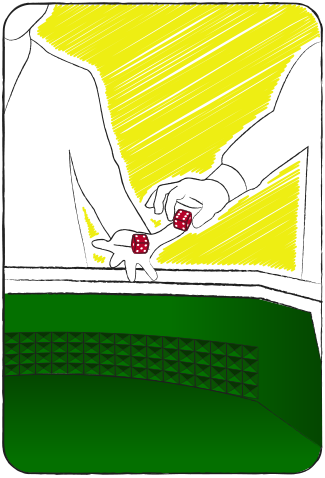
![]()
| Bet | Payout | House Edge |
|---|---|---|
| Pass | 1-1 | 1.41% |
| Come | 1-1 | 1.41% |
| Don't Pass | 1-1 | 1.36% |
| Don't Come | 1-1 | 1.36% |
| Bet | Payout | House Edge |
|---|---|---|
| Pass or come with 1x odds | Varies with point | 0.8% |
| Pass or come with 2x odds | Varies with point | 0.6% |
| Pass or come with 3x odds | Varies with point | 0.5% |
| Pass or come with 3x, 4x, 5x odds | Varies with point | 0.4% |
| Pass or come with 5x odds | Varies with point | 0.3% |
| Pass or come with 10x odds | Varies with point | 0.2% |
| Pass or come with 20x odds | Varies with point | 0.1% |
| Pass or come with 100x odds | Varies with point | 0.02% |
| Bet | Payout | House Edge |
|---|---|---|
| Don’t pass/don’t come, 1x odds | Varies with point | 0.7% |
| Don’t pass/don’t come, 2x odds | Varies with point | 0.5% |
| Don’t pass/don’t come, 3x odds | Varies with point | 0.3% |
| Don’t pass/don’t come, 3x, 4x, 5x odds | Varies with point | 0.3% |
| Don’t pass/don’t come, 5x odds | Varies with point | 0.2% |
| Don’t pass/don’t come 10x odds | Varies with point | 0.1% |
| Don’t pass/don’t come 20x odds | Varies with point | 0.07% |
| Don’t pass/don’t come/100x odds | Varies with point | 0.01% |
| Bet | Payout | House Edge |
|---|---|---|
| Place 6 or 8 | 7-6 | 1.52% |
| Place 5 or 9 | 7-5 | 4% |
| Place 4 or 10 | 9-5 | 6.67% |
| Bet | Payout | House Edge |
|---|---|---|
| Buy 6 or 8 with 5% commission | 6-5 | 4.67% |
| Buy 5 or 9 with 5% commission | 3-2 | 4.67% |
| Buy 4 or 10 with 5% commission | 2-1 | 4.67% |
| Buy 6 or 8, commission on winners only | 6-5 | 2.27% |
| Buy 5 or 9, commission on winners only | 3-2 | 2% |
| Buy 4 or 10, commission on winners only | 2-1 | 1.67% |
| Bet | Payout | House Edge |
|---|---|---|
| 2 | 30-1 | 13.89% |
| 12 | 30-1 | 13.89% |
| 3 | 15-1 | 11.11% |
| 11 | 15-1 | 11.11% |
| Any 7 | 4-1 | 16.67% |
| Any craps (2, 3 or 12) | 7-1 | 11.11% |
| Hard hop | 30-1 | 13.89% |
| Easy hop | 15-1 | 11.11% |
